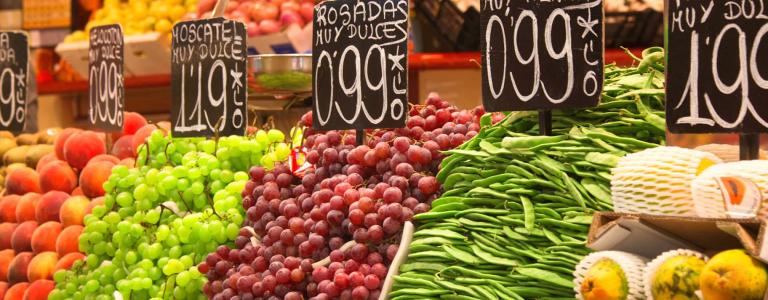Food Prices Hover Near Record Highs With Little Respite in Sight
Russia’s invasion on Ukraine is threatening global food security as grain exports decline, countries turn to food protectionism in fear of future shortages, and sanctions on Russia and Belarus send prices of a key fertilizer nutrient to levels not seen since the 2008 food crisis.
Global food prices, already on the rise since mid-2020 due to the COVID-19 crisis, are remaining close to record highs as Russia’s attack on Ukraine continues to crimp exports of grains such as wheat and barley. Countries are also hoarding staples to protect themselves from shortages, thus limiting supplies on the international market. Food prices will likely continue to rise through 2023.
While the FAO Food Price Index eased by 0.8% in April from March, as prices of major staples such as vegetable oils and cereals fell, it held close to the previous month’s record high as meat reached the highest level ever, and dairy and sugar prices climbed. The gauge had surged 12.6% in March—the fastest pace ever recorded—in the immediate aftermath of Russia’s invasion. The World Bank predicts that wheat prices could rise more than 40% this year before declining in 2023. However, that depends on increased crop supplies from Argentina, Brazil, and the United States—which is by no means guaranteed.
Concerns about food security amid Russia’s invasion of Ukraine, one of the world’s biggest grain and vegetable oil exporters, have led 23 countries to turn to food protectionism to ward off future shortages, according to the International Food Policy Research Institute. This limits supplies on the global market and drives up prices.
Indonesia, for instance, banned most exports of palm oil in late April to ensure domestic supplies of cooking oil, cutting off supplies from the top producer of the most traded vegetable oil in the world. Similarly, India is reportedly considering restrictions on wheat exports to protect domestic stocks following searing heat in March and April that fuelled concerns about the country’s supply.
Russia and Ukraine account for nearly a third of global wheat and barley and two-thirds of the world’s export of sunflower oil used for cooking. Ukraine is the world’s fourth largest corn exporter. The war has damaged Ukraine’s ports and agricultural infrastructure, and that’s likely to curb the country’s farm production for years.
United Nations Secretary-General Antonio Guterres said in early May the problem of global food security could not be solved without restoring Ukrainian agricultural production and Russian food and fertilizer output to the world market. Sanctions on Russia and Belarus, the world’s second and third biggest producers of potash, have sent prices of the key fertilizer nutrient to levels not seen since the 2008 food crisis. Russia is also one of the top suppliers of other crop nutrients, such as nitrogen, phosphate, urea, and ammonia. The sharp rise in fertilizer prices could discourage farmers from applying adequate crop nutrients to their fields, bringing down yields and resulting in lower production, prolonging the crisis.
Furthermore, there have also been weather-related problems with key crops in many parts of the world. Brazil, the world’s biggest soybean exporter, suffered from severe drought in 2021, and China’s wheat crop this year has been one of the worst ever.
The Global Network Against Food Crises, set up by the United Nations and the European Union, said in its annual report that Russia’s invasion of Ukraine poses major risks to global food security, especially in 53 countries/territories already facing a food crisis, such as Afghanistan, Burkina Faso, Ethiopia, Haiti, Somalia, South Sudan, Syria, and Yemen.
You might also be interested in
Canada's LNG Pipe Dream Is an Unsustainable, Bad Investment: Report
The Canadian taxpayer is already betting billions on a supposed boom in liquified natural gas but is this a wise investment given how quickly renewable energy and battery storage are transforming the global economy? The answer is a resounding "no" according to a report released by IISD that looked at shifting global markets and how Canada's LNG industry could undermine our climate goals.
Carbon Minefields: Oil and gas exploration surging to pre-Covid levels
Oil and gas exploration is booming despite an agreement at last year’s COP 28 climate summit to transition away from fossil fuels.
Volatile Costs of Fossil Fuel Energy were a Key Driver of Recent Record Inflation and Continue to Impact Affordability
New report takes closer look at how Canada’s dependence on fossil fuels impacts energy costs and prices of essentials such as transportation, home heating, and housing.
Carbon taxes did not trigger spike in Canadian gas prices, finds report
In the year leading up to June 2022, average gasoline prices climbed 55 per cent across Canada, part of a wave of inflation that raised the cost of nearly everything from rent to food. According to a new IISD analysis published Wednesday, a $0.73 jump in gasoline prices over that period was almost entirely driven by the global oil market—not carbon pricing.
